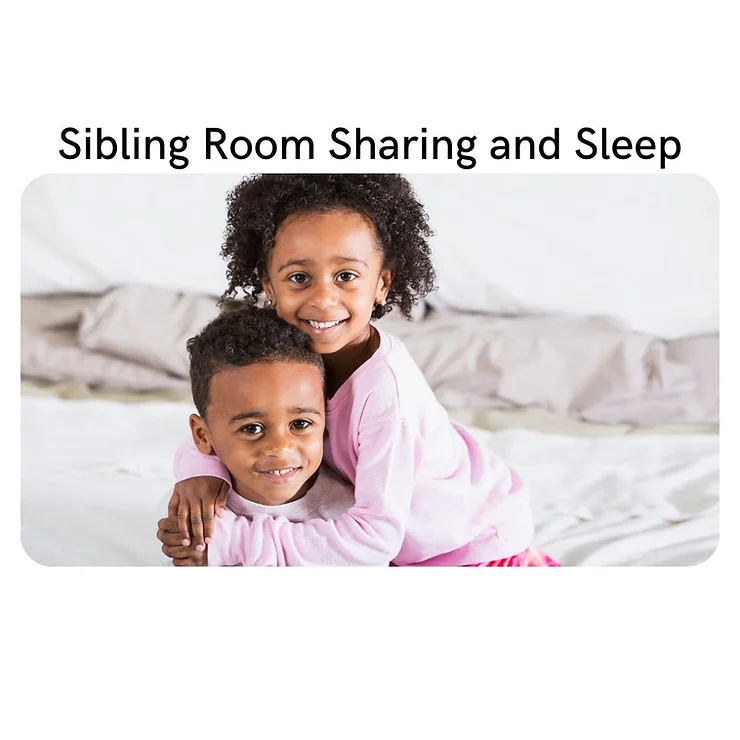Sibling Room Sharing and Sleep
Some siblings share a bedroom out of pure necessity and space limitations. Some parents choose for siblings to room share to facilitate a close bond. Many of us grew up sharing a room with a sibling and want to recreate similar memories with our own kids.
But how does sibling room sharing impact sleep?
It depends on the children, the family, the room, the timing, the routines, and the boundaries around sleep!
Yes, of course, the presence of another person in your child’s sleep environment is going to impact sleep simply because it’s one more variable and distraction.
Yet – sibling room sharing can still work very well with a comprehensive and well thought out plan.
In general, for sibling room sharing to work, all room sharing sleepers need to have strong independent sleep skills and healthy sleep habits. It’s simply not fair or sustainable to have one child that is relying on another child to sleep well. It’s lovely to have siblings that can support each other and help one another here and there, but it should never be one child’s job to help another fall asleep at bedtime or in the middle of the night.
I strongly encourage parents to work on healthy independent sleep skills with all room sharing children individually and before moving into a shared room.
If your little sleepers don’t have strong sleep skills yet, no problem because it’s never too late to support their learning process and there is always a way!
I recommend starting with your youngest and moving them into their own sleep space temporarily to make the process of learning independent sleep skills as easy as possible for them. This might be a pack n play set up in a spare room or office, or even in a parent’s bedroom with the parents taking one for the team and spending a few nights on the living room couch or blow up.
Once your younger child is a ‘sleep-through-the-night-master’, it’s time to focus your efforts on improving your older child’s independent sleep skills. Best to keep their environment as consistent as possible, but still to offer a solo sleep environment while they learn how to fall in love with sleeping through the night. Sometimes it works well to have the younger child’s empty crib or ultimate sleep space set up in the older child’s room so they can join in later once everyone is a super sleeper.
It won’t be long before you have two dream-team sleepers with strong independent sleep skills who can sleep through the night, and you can happily make your way back to your own bed if you were sleeping on the couch temporarily.
Now it’s time to move your ready-to-room-share kiddos into their shared bedroom. It’s reasonable to expect some minor sleep disruptions initially because sharing a sleep space is exciting! And you’ve added a new variable to both of their sleep environments. You’ve set them up for success by teaching them both strong sleep skills, but new and exciting is always a risk. Luckily, children with strong sleep skills tend to be well rested children who also tend to be more adaptable to occasional changes and transitions.
3 Tips for a Smooth Room Sharing Transition
ONE.
First, the room should be super conducive to sleep. This means dark, a continuous white noise machine or TWO to block ambient house and sibling noises. This also means boring. While there may be more than one child sleeping in the room, it should not resemble a playroom. Tuck away distracting toys, or keep them in a different room entirely to minimize the temptation to play during sleep times.
TWO.
Next, an appropriately timed bedtime is everything. While the exact best bedtime is going to vary from child to child, it’s true that babies, toddlers, and preschoolers thrive on an early to bed and early to rise lifestyle. A bedtime between 6pm and 8pm is ideal for most young children. Oftentimes, if settling down at night is an issue, one big contributing factor is that bedtime is simply too late.
With two (or more) kiddos sharing a room, you can choose to go about bedtime in a couple of different ways.
One option is to do the bedtime routine and bedtime together.
This can work well for children with very similar sleep needs. Expect for it to take longer than usual for both kids to fall asleep at first. In fact, shift bedtime 15 minutes earlier than usual to alot for an extra 15 minutes for them to be silly together after lights out. This silliness will be more cute versus annoying if you have allotted the time for it in advance 🙂
Another option is to stagger bedtimes.
This can work well for children with different sleep needs, or an older child who will be motivated by extra one on one time with their parent. In this scenario, the younger child has an earlier bedtime routine and bedtime, while the older child has a bedtime routine that happens outside the bedroom and ends once the younger child is already in a deep sleep. This option comes with a very important rule. The older child has to go into the shared room very quietly after the bedtime routine ends. If the older child can follow this rule, then they get to have special big kid one on one time with their parent every night before bed. So cool! If they are NOT able to follow this rule, then the logical consequence is that they will have to go to bed at the same time as their younger sibling. Oftentimes, special one on one time with a parent is enough to incentivize following the one very important rule.
THREE.
Lastly, prepare for the morning. If one of your sleepers tends to be an early bird, it’s best if the other child is a deep sleeper 🙂 Otherwise, both children may be starting the day bright and early. Use an OK to Wake clock that is set to indicate morning time no earlier than 6am, but may be set to your own family’s later OK to Wake time as well. OK to Wake clocks are not magic, but they sure do feel like magic if you put the initial effort into following through.
If sibling room sharing is either a choice or necessity in your family, know that it can work very very well. For some families it will work well easily without much issue at all. For many other families, it will be a transition and will take time to adjust. Sleep transitions always work best with a plan and this one works best if both sleepers have strong independent sleep skills before the transition to room sharing.
Here is a reminder of my top 5 healthy sleep tips for babies, toddlers, and preschoolers.
And here is a link to browse my one-on-one Sleep Services, or to go ahead and schedule a free 15 minute discovery call to learn more about working with me to make this exciting transition a successful one!

